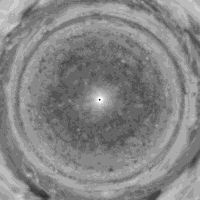

This animated north-polar view in the near infrared demonstrates the unearthly straightness of Jupiter's jets, where `straightness' means that the jets follow parallels of latitude (Porco et al. 2003: Cassini Imaging of Jupiter's Atmosphere, Satellites, and Rings, Science 299, 1541-1547, movie S1).
The observed jet straightness, unearthly because it differs so strikingly from the large-amplitude, long-wavelength meandering of terrestrial strong jets -- such as the great tropopause jetstreams and the Gulf Stream, Agulhas and Kuroshio currents -- is evident even in moderately high latitudes where the Rossby deformation lengthscale is quite small, in the ballpark of 1000 km by most estimates. With such small values relative to the planetary radius ∼ 70,000 km, the high-latitude jets in weather-layer-only models tend to meander strongly.
The jet straightness cries out for a fluid-dynamical explanation. Stephen Thomson and I have developed a possible such explanation, based on a new idealized model of weather-layer dynamics that begins with the classic Dowling-Ingersoll scenario, taking account of Arnol'd's second stability theorem. Among other things the work suggests a fruitful way to work with Jovian general circulation models, bypassing the severe uncertainties about lower boundary conditions. The results are presented in our paper Jupiter's unearthly jets: a new turbulent model exhibiting statistical steadiness without large-scale dissipation, published in J. Atmos. Sci.. A reprint is available here (pdf, 1.6 Mbyte, © 2016 American Meteorological Society, J. Atmos. Sci. 73, 1119-1141). It includes an important clarification about radiative timescales. Some surprising aspects of the fluid dynamics are summarized in a short conference paper Turbulence without cascades -- new insights from Jupiter's unearthly jets available here.
A movie of the weather-layer flow in our model is available here (22.6 Mbyte). It is discussed in section 5 of the reprint. For further information see Stephen's web page.
A higher-resolution .mov version of the NASA Cassini animation is available here and, with further explanatory notes, from www.nasa.gov at this page.